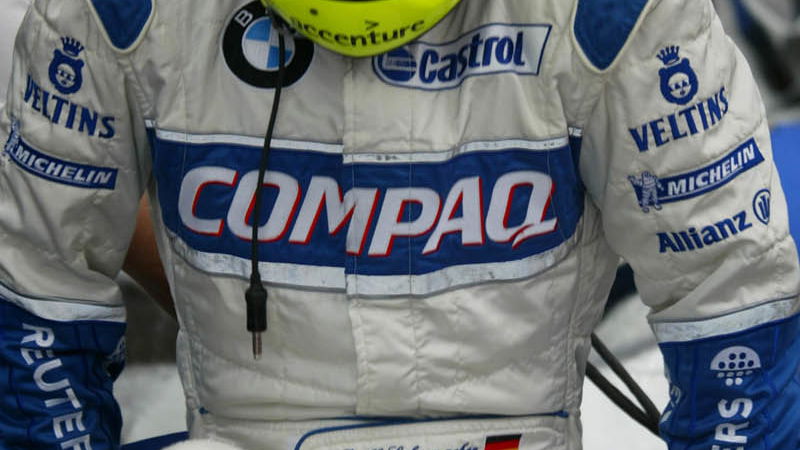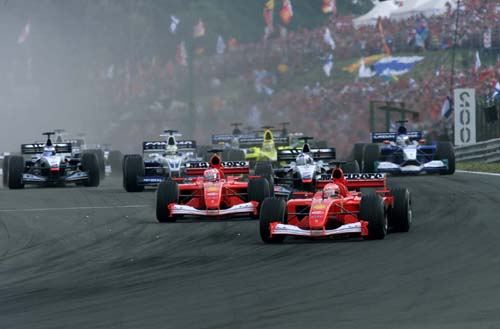BMW develops head-up display for Ralf's helmet.
In the run-up to the Hungarian Grand Prix, the BMW Technology Office takes the wraps off an innovative Formula One product.
A miniature head-up display system in the size of 6x8 millimeters integrated in Ralf Schumacher's helmet will enable a wide range of information and messages to be relayed to the driver.
With this "visual information window" BMW is setting new standards for safety in Formula One. It means racing drivers can register visual information while still paying full attention to their driving.

In the run-up to the Hungarian Grand Prix, the BMW Technology Office takes the wraps off an innovative Formula One product.
A miniature head-up display system in the size of 6x8 millimeters integrated in Ralf Schumacher's helmet will enable a wide range of information and messages to be relayed to the driver.
With this "visual information window" BMW is setting new standards for safety in Formula One. It means racing drivers can register visual information while still paying full attention to their driving.
Aided by this innovative technology, the driver can be alerted, for example, to an accident on a certain stretch of the track or a patch of oil in a particular turn.
"With this device, BMW has taken a further important step forward on the safety front," says Ralf Schumacher of the BMW WiliamsF1 Team. The display system was devised by the BMW Technology Office based in Silicon Valley's Palo Alto in collaboration with a local partner company specializing in electronics and with the German helmet manufacturer Schuberth.
Ralf will use the mini head-up display in his helmet starting with the forthcoming season.
This pioneering technology opens up an entirely new channel of communication between the pits and the driver. A module integrated in the helmet stores various messages and images in a data set, which can be called up from the pits and displayed to the driver.
The mini head-up display projects the relevant "transparent" image through the visor on a level with the front of the car. The driver registers the information without being distracted from what is happening on the track.
The BMW mini head-up display has a high-resolution true color display based on active matrix liquid crystal display (AMLCD) technology. The key function of the display is found in a unique lens element known as a free form prism (FFP). Thus the driver is able to see the picture pin sharp.
Formula One as an ideal application and test area:
The mini head-up display enables the projection of any number of optical messages into the driver's direct field of vision.
For Formula One testing, the miniature display was integrated into the chin cup of a modified Schuberth RF-1 racing helmet. Additional walls and padding were used in accordance with guidelines from the SNELL Foundation (the helmet safety organization).
The system is located in the peripheral vision field of the driver's dominant eye. Thanks to the unique design of the system, the information is projected into the driver's field of vision without his having to actually look at the display.
"The eye very quickly gets used to this small spot and ignores it as if it were a tiny insect on the windscreen," explains J?rgen Br?gl, project engineer at the BMW office in Palo Alto.
With the help of the miniature display, the F1 driver is fed a wide range of information on the race and on safety precautions straight from the pits. It means the driver is permanently informed of his position in the race, can receive instructions from the pits during the race and training, such as "go faster", "come into the box" or "oil in turn 2", and is kept up to date on flag signals and emergency procedures by means of messages such as "pit traffic" or "oil pump".
Moreover, it allows the instructor in the pits to send the driver an SMS through bi-directional telemetry. This information is relayed straight to the display. Similarly, information on the engine management (e.g. "oil pressure low") can be sent directly to the driver without having to go through the pits. It all helps to save precious time.
Network-style innovation management as the basis of technological progress...
The integral head-up display was developed in the westernmost office of the BMW Group's Research and Technology Center (FIZ), right in the middle of Palo Alto in Silicon Valley. Since 1998, 16 associates - IT experts, logisticians, chemists and engineers from various specialist fields - have been working towards a common objective, namely to ensure the fastest possible integration of innovative technologies into BMW cars.
"Thanks to our Technology Office we have our finger on the pulse of the time and are in a position to harness the rapid developments in communications and information technology in Silicon Valley to our own purposes," says Dr. Burkhard Goeschel, BMW Group board member responsible for Development and Purchasing. The BMW Technology Office specializes in highly innovative, cutting-edge technologies.

